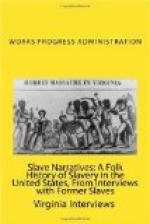“The present times is hard. I get ten dollars a month. I don’t know what to say about folks now—none of them.”
Interviewer: Pernella Anderson
Person Interviewed: Annie Mae Weathers
East
Bone Street
El
Dorado, Ark.
Age: ?
“I was born bout the second year after surrender right down here at Caledonia. Now the white folks that ma and pa and me belonged to was named Fords. We farmed all the time. The reason we farmed all the time was because that was all for us to do. You see there wasn’t nothin’ else for us to do. There wasn’t no schools in my young days to do no good, and this time of year we was plowin’ to beat the band and us always planted corn in February and in April our corn was.
“We fixed our ground early and planted early and we had good crops of everything. We went to bed early and rose early. We had a little song that went like this:
Early to bed and early to rise
Makes a man healthy, wealthy, and wise.
and
The early bird catches the worm.
Cooked breakfast every morning by a pine torch.
“I member hearin’ my pa say that when somebody come and hollowed: ’Yer niggers is free at last’ say he just dropped his hoe and said in a queer voice: ‘Thank God for that.’ It made old miss and old moss so sick till they stopped eating a week. Pa said old moss and old miss looked like their stomach and guts had a law suit and their navel was called in for a witness, they was so sorry we was free.
“After I got a good big girl I was hired out for my clothes and something to eat. My dresses was made out of cotton stripes and my chemise was made out of flannelette and my under pants was made out of homespun.
“Our games was ‘Honey, honey Bee,’ ‘Ball I can’t Yall,’ and a nother one of our games was ‘Old Lady Hypocrit.’”
Interviewer: Samuel S. Taylor
Person interviewed: Cora Weathers
818
Chester Street, Little Rock, Arkansas
Age: 79
“I have been right on this spot for sixty-three years. I married when I was sixteen and he brought me here and put me down and I have been here ever since. No, I don’t mean he deserted me; I mean he put me on this spot of ground. Of course, I have been away on a visit but I haven’t been nowheres else to live.
“When I came here, there was only three houses—George Winstead lived on Chester and Eighth Street; Dave Davis lived on Ninth and Ringo; and George Gray lived on Chester and Eighth. Rena Lee lived next to where old man Paterson stays now, 906 Chester. Rena Thompson lived on Chester and Tenth. The old people that used to live here is mostly dead or moved up North.
“On Seventh and Ringo there was a little store. It was the only store this side of Main Street. There was a little old house where Coffin’s Drug Store is now. The branch ran across there. Old man John Peyton had a nursery in a little log house. You couldn’t see it for the trees. He kept a nursery for flowers. On the next corner, old man Sinclair lived. That is the southeast corner of Ninth and Broadway. Next to him was the Hall of the Sons of Ham.




